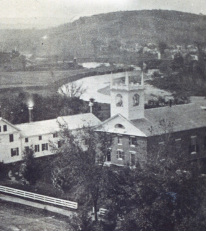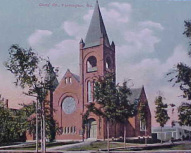
Here’s a look back as the Old South First Congregational Church in Farmington celebrates 200 years since it was established in 1814.
By Megan Roberts
FARMINGTON – It was in 1780 when pioneer Stephen Titcomb came to Farmington and built a cabin, and then spent the long winter as the first white settler here. His family joined him in the spring and his son born was the first white to be born in this new settlement.
Ten years later, the census boasted of 63 children born and 494 inhabitants had settled in this fertile land of the Sandy River.
There were traveling preachers who ministered to small towns developing during those early years, and the Titcomb cabin was one of their regular stops for providing services to the townfolk who gathered. When missionary Father Jotham Sewall moved to Chesterville in 1788, his dynamic personality and organizational skills, as well as his superior preaching, gave the area a spiritual boost. It also established a new church that is directly connected to the present day church in Farmington.
Most Congregationalists of Chesterville had been going to the Hallowell Parish until 1796 when, under Father Sewell’s guidance, they formed their own organization in Chesterville. The Chesterville church strengthened as some of the Farmington Congregationalists joined the Chesterville group, forming the “Chester and Farmington Church.”
In 1803 several denominations got together to build the “Center Meetinghouse,” located at the site of the current Franklin County Courthouse on Main Street in Farmington, as a central place for worship and activities.

The denominations shared this space and preachers, and it was in 1814 that the group of Congregationalists felt they had the strength and numbers to stand as a separate organization.
Thus began the “First Congregational Society,” which is now called the Old South First Congregational Church, UCC, that is celebrating an amazing 200 years this year.
Clerk Jotham Sewall recorded: “The Council met in Farmington and embodied a church consisting of 12 members, Dec. 14, 1814.” This was a move of great faith, considering that they didn’t have their own pastor, their own church building, or large families within their membership.
They grew slowly but steadily, still gathering at the Center Meetinghouse, and in 1825 they hired Isaac Rogers as their first full-time minister. Still growing and at almost 150 members in 1936, they built their own meeting house on the site of the current church. Rev. Rogers remained their minister until 1858, serving them well during his 33 years as minister. The church now had a strong foundation and future.

Membership continued to grow, and by the 1880s there were over 200 members. Heavily debated was whether an addition to the overflowing church should be built, with the conservatives against it. The decision was forcefully made by the great fire of 1886, which destroyed most of Farmington, including the Congregationalists’ church.
Members rallied and sought funds from their connections from all over the United States and beyond, finding generous donations in their hands for rebuilding a spacious, modern church.
Beautiful stain glass windows were paid for as people memorialized their loved ones. Equipment was donated, the pulpit, three chairs used on the platform, a communion table, and the Bible and Flowers Table were all given, often in memory or celebrating people of the church. Music was to come from an elegant Ivers and Pond upright piano. It was a glorious day in June when they dedicated their new church, debt-free and truly inspirational, a church that proudly remains the church of today’s congregants.
In 1892 the First Congregational Church was incorporated. In 1894 a new organ was installed, ushering in the importance of fine music in the church services that continues to this day. In 1957, a new M. P. Moller organ console was installed. The church thrived through the years, making improvements to the basement and becoming involved in the state Congregational organization, holding the state conferences at Old South, which the church became known as.

In 1956 it was voted to raise the large sum of an $11,000 contribution for a Congregational Christian Camp, now called Pilgrim Lodge. This Christian family camp has provided wonderful lakeside summer experiences for the families of Old South UCC and others throughout the state for over 55 years, and continues today. In 1960 the church voted to join the United Church of Christ.
The growth continued into the 1960s, reaching over 400 members. The basement was renovated into Sunday School classrooms and a children’s chapel. As the years continued, renovations and repairs were made as needed to all parts of the church, including the stain glass windows, the sanctuary, the kitchen, the organ, and the beautiful bell and belfry.
In the 1990s and 2000s, the physical church expanded with the purchase of the Holman House and the building of a wing on to the main church. The Holman House is a large historic house next door to the church, where the church offices are located, with a portion of the house rented out. The two-story wing has classrooms, a children’s nursery, a chapel, and a large all-purpose meeting room.
As with most organizations, the Old South Church over its 200 years has had its ups and downs, its times of prosperity and its times of need, its times of unity and of division, of enthusiasm and lack thereof. The underlying beliefs, faith and commitment, and the continuing love for one another have always succeeded in keeping the church together and moving forward, allowing the church to celebrate an enduring and inspiring 200 years.
Information for this article came from the 1915 “Centennial of the First Congregational Church,” a publication by the church; the 1965 “History of Old South Church, Farmington, Maine” by Natalie and Ben Butler, and other church programs and publications.





Paul Mills did point out to me that although emotionally for many it may have felt like the whole town burned n 1886, but the reality was that a good section of the downtown was spared. It didn’t help the Congregationalist to know that, though!
It’s interesting to note that while many of the pews had owners, so did the stable stalls. I’ve seen deeds that people paid a “sum” of money; later on they sold their interest to others. That was pre-1886 fire, so perhaps the tradition didn’t continue.
The Historical Society has several letters signed by Rogers; in addition, they have other misc. documents pertaining to the pre-fire era.